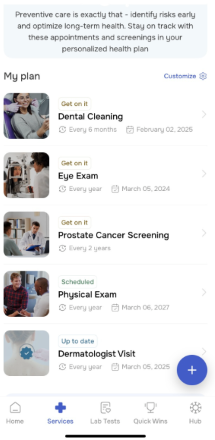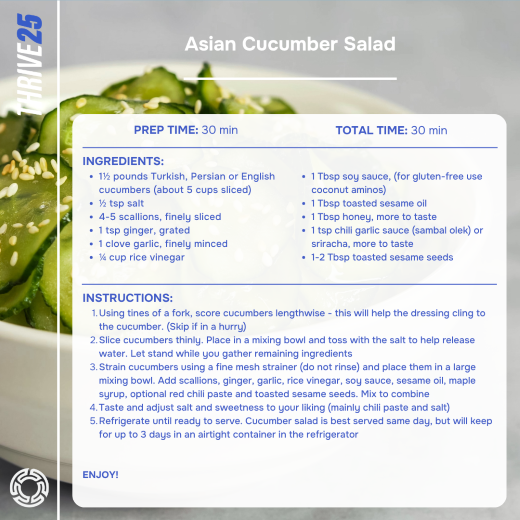Issue #466: Are Biological Age Tests Legit?
Good morning. It’s Tuesday, August 12th.
In today’s email:
Learn: The Unproven Hype of Biological Age Tests
Try: Prevention Matters
Focus: What “Super Agers” Have in Common
In the News: Thrive in the Heat
Cook: Asian Cucumber Salad
Brain Games: Logic Equations
Stat of the Day
The standard deviation (think variance) in years from the same sample being sent to 4 different biological age test companies. Let’s just say - it’s not an exact science yet. (Dr. Matt Kaberlein)
Learn
The Unproven Hype of Biological Age Tests
There’s apparently a better way to tell how old you are than just counting your birthdays - your biological age.
It’s supposed to measure how old your body is functioning.
Right now, the most popular way to measure biological age is through epigenetic clocks.
These tests look at patterns of DNA methylation - tiny chemical tags that sit on top of your DNA and influence which of your genes are turned on or off.
You simply send in a blood or saliva sample, the lab measures thousands of these markers, and an algorithm predicts your “biological age.”
If you’re 44 like me, but have a biological age of 40 - then it stands to reason that I’m aging slower than the average person. Then the logic would follow that I should live at least 4 years longer than the average for my age, gender, wealth, etc.
On the flip side, if my biological age is 50, then I’m aging too quickly and longevity is a pipe dream, unless I make some real changes starting now.
But what if you’re both?
Dr. Matt Kaeberlein recently took the exact same blood sample and sent it to four companies. He actually sent two samples to each lab to confirm the consistency of their analysis.
Here’s what happened:
True Diagnostic: One test was 60.7 years old, the other 47.8 - umm… that’s a difference of nearly 13 years from the same tube of blood.
Tally Health: 61 vs. 59 years
Elysium: 45 vs. 43 years
Mudo: 56.6 vs. 56.2 years - the most consistent
Matt’s real age? 53.1 years.
YouTube - Dr. Matt Kaeberlein
So the same test thinks he’s really old for his age and really young for his age. The standard deviation (variance) was 7.4 years. Not exactly giving me the confidence that these results are telling me anything real. See his full video HERE.
There’s another problem with these tests too.
Dr. Steven Horvath - one of the scientists who invented these clocks - posted data showing soccer players’ biological age dropped dramatically right after a 90-minute match…only to bounce back close to the initial result within 24 hours.
He claims to be making the point that just like other biomarkers and blood tests - when you take the test matters.
My takeaway? I’m not a PhD, but if a single workout can “reverse” your biological age by years in an afternoon, it’s not a stable measure of your actual biological state.
Now, I’m not suggesting to absolutely avoid these tests. But I’m saying they are NOT (today) a substitute for real blood tests and preventive screenings.
Two years ago, James Van Der Beek (aka Dawson, aka Mox) was diagnosed with stage 3 colon cancer. He was 46 at the time and probably as healthy as most of all of us.
He didn’t have a family history and was in great cardiovascular health. He only got screened as he started seeing changes in his stool - by then it was already late in the game.
Fortunately - he’s got a 91% five-year survival. But that doesn’t mean it’s not affecting his life.
“I could no longer be a husband who was helpful to my wife…I could no longer be a father who could pick up his kids…I could not be a provider because I wasn’t working.”
Don’t get distracted by the latest test being sold to you - focus on the basics that are going to save your life and give you the insights you need to get ahead of anything that could come between you and longevity:
Preventive screenings (colonoscopy, mammogram, skin checks)
Comprehensive lab tests
Annual appointments (physical, dental)
Try
Prevention Matters
Based on your age and gender - there are a number of preventive appointments and screenings that you probably have covered under your current insurance plan.
Don’t wait until it’s too late to find out about something that’s already happening inside your body that could impact your future health.
Not sure where to start, what to ask your doctor when you get there, or where to store your notes and results?
👉 Check out the Thrive25 Personal Longevity Advisor - it’s your guide to optimize your health!
Thrive25 Partner Spotlight
This Daily Ritual Goes Wherever You Do
Summer travel often means skipped meals, red eye flights, and way too many pastries.
AG1 helps you stay on track with 75+ vitamins, minerals, pre/probiotics, and adaptogens for energy, gut and immune support.
Subscribe to get AG1 + 10 free travel packs, and more—all for under $3 a day.
Focus
What “Super-Agers” Have in Common
A “super-ager” - someone over 80 years young with a memory and cognitive function that can rival most 50-60 year olds.
As much as we talk about it in this newsletter - there’s no magic longevity bullet - these super-agers don’t have a specific diet, supplement or even workout plan.
A 25-year long study from Northwestern shows what we’ve seen from other research - they all value and prioritize relationships.
It means never stopping to engage with friends; it means continuing to book a full day of activities; it means being an active part of your community.
When you do that scientists found that you:
Maintain larger brain volume compared to typical 80 and 90-year olds
Have more von Economo neurons - specialized brain cells found in highly social species (humans, apes, elephants, whales) that seem to help us build and maintain close social networks
Preserve better function in brain chemicals tied to attention and memory
Show less Alzheimer’s pathology than most people your age
Loneliness, on the other hand, raises cortisol (the stress hormone).
When cortisol stays high for too long, it can cause chronic inflammation - damaging brain cells and raising dementia risk.
Cause or Effect?
Does socializing cause sharper cognition or are you more likely to socialize if your brain is still firing? It’s probably both.
But if we start putting ourselves out there now - then either way we’re in a better place when we’re 80 and 90.
Too many of us don’t prioritize our friendships or social lives - we’re either tied to our jobs, underwater balancing work/family, or we spend too much time alone.
No matter your situation - get out there. Humans are social animals and life is only worth living when doing it with other awesome people.
H&L in the News
Heat Hack Your Fitness: Training in summer heat boosts VO2 max, endurance, and red blood cells - like DIY altitude training. Learn how to adapt safely and reap fall performance gains without burning out. (NYTimes)
Deskbound? Stretch It Out: Back pain at your desk? These 5 yoga stretches, approved by a top instructor, target tension in your spine, glutes, and hips - without ever leaving your chair. Relief starts now. (Outside)
Live Longer, Feel Younger: Healthspan beats lifespan. Backed by science, these 5 surprising strategies - from cold plunges to cutting xenoestrogens - can help you stay sharp, strong, and vibrant well into old age. (Big Think)
Cook
Asian Cucumber Salad
This Asian Cucumber Salad is the ultimate summer side - cool, crisp, and bursting with flavor. Hydrating cucumbers support skin and gut health, while sesame oil and seeds deliver healthy fats and antioxidants. Ginger, garlic, and rice vinegar add a zesty kick, and it’s fully vegan and gluten-free. Serve it with bowls, proteins, or enjoy it solo - it’s quick, refreshing, and always a crowd-pleaser. 🥒🌿
Brain Games
Logic Equations
7 variables today - A, B, C, D, E, F and G - with seven possible values - 1, 2, 3, 4, 5, 6, 7. None of the variables can share the same number. Based on the following equations, what do the variables equal:
C = DF
F = G + 2
B + D = A + G
It might be 7 variables and only 3 equations, but get out the stop watch and see how fast you can solve!
Credit: Brainzilla
** For answer, scroll to the bottom of the email
Thanks for joining us today!
Want to see what we’re up to? Sign up for early access to our platform
Check out the latest videos on our YouTube channel
Got feedback, recommendations or stories to share? Tell us what’s on your mind here
Want this direct to your inbox? Sign up here
Brain Games Answer
Answer: Yellow are the values for the variables. A=5, B=4, etc.
Why?…
Start with equation (2). To be possible, F ≥ 3 and G ≤ 5
Now, look at equation (1). C cannot be an odd number ≤ 7, and it can’t be 2 or 4 because C, D or F would need to share the same number. So C = 6. Since we know F ≥ 3, then F = 3 and D = 2. Finally, based on our last step, if F = 3, then G = 1
Now, let’s plug the known values into equation (3)…B + 2 = A + 1. Rearrange this to find that B + 1 = A. The remaining available numbers are 4, 5 and 7. Only 4, 5 are within 1 digit, so A = 5 and B = 4. The last remaining variable is E, so E = 7
✅ How long did it take you?
Why Thrive25
We’re 40-something dads that felt our bodies and minds start to slow down and we’re not ready for that. We found too much information on every subject. So we started Thrive25 to transform what we’ve learned into something useful for the rest of us to spend just 3-5 min a day to optimize our health & longevity.
This newsletter is for you and we truly value your feedback. Never hesitate to reach out to us at team@thrive25.com.
To health!
Sign up for free:
The information in this newsletter is for informational purposes only and may not be appropriate or applicable based on your individual circumstances. Thrive25, Inc. does not provide medical, professional, or licensed advice. Please connect with your healthcare professional for medical advice specific to your health needs.












